 View fulltext
View fulltext
A new D-shaped tellurite photonic crystal fiber sensor based on the four-wave mixing (FWM) effect with the surface plasmon resonance (SPR) effect is designed and optimized. The substrate of the D-shaped photonic crystal fiber (D-P
An in-fiber Mach-Zehnder interferometer is proposed for the discrimination of strain and temperature. The sensor is based on two cascaded standard single mode fibers using three peanut tapers fabricated by simple splicing. The cas
In this study, we experimentally demonstrate a miniature fiber thermometer based on tip-integrated ZnO-nanowire-nanograting. The sensor has a diameter less than 1 μm and the length of the Bragg grating is sub-10 μm. The ZnO-nanowi
Sensing sensitivity is the key performance of optical tweezers. By adjusting the frequency and magnitude of an applied Coulomb force as an input of optical tweezers, we directly measured the sensitivity and signal-to-noise ratio (
Deviation of the H+ concentration from optimum values within the organelles is closely associated with irregular cellular functions that cause the onset of various diseases. Therefore, determining subcellular pH values in live cel
Metalens are planar lenses composed of the subwavelength arrays, which have unconventional and versatile functionalities to manipulate the light fields compared with the traditional lens. It is noted that the most metalens are des
The strain-temperature cross-sensitivity problem easily occurs in the engineering strain monitoring of the self-sensing embedded with fiber Bragg grating (FBG) sensors. In this work, a theoretical investigation of the strain-tempe
Side polished fiber (SPF) has a controllable average roughness and length of the side-polishing region, which becomes a versatile platform for integrating multiple materials to interact with the evanescent field to fabricate all-f









